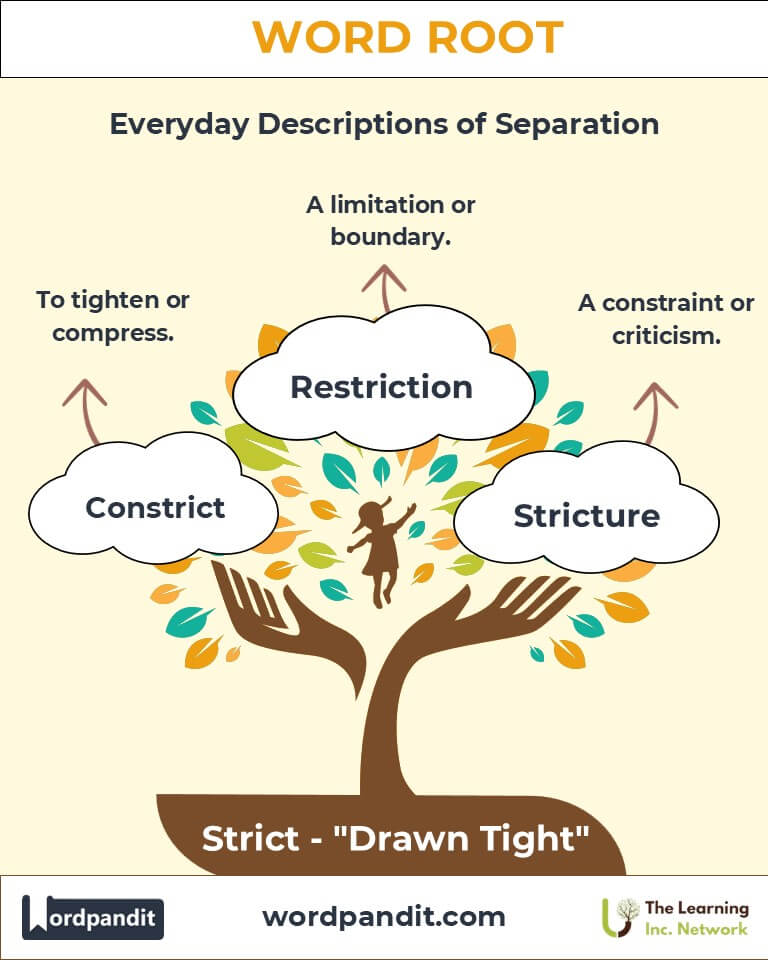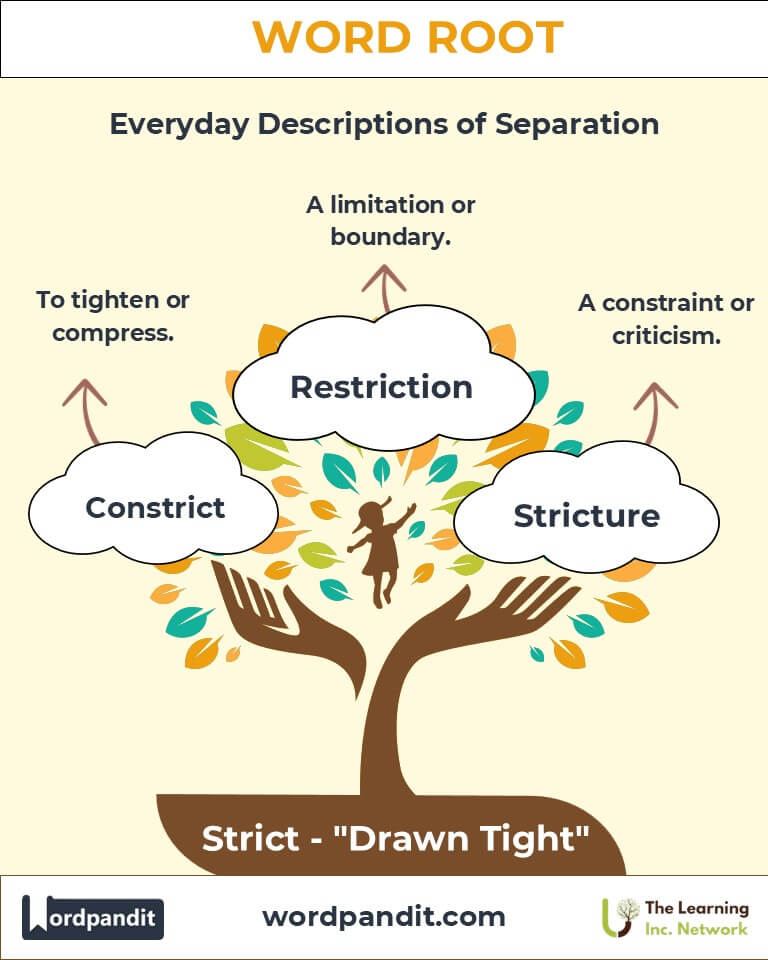Strict: The Root of Control and Boundaries in Language and Life
Explore the linguistic depth of the root "strict," originating from the Latin strictus, meaning "drawn tight" or "narrowed." From words like "restriction" to "constrict," this root underscores the themes of control, limitation, and focus that shape our language, disciplines, and daily experiences.

Table of Contents
- Introduction: The Essence of "Strict"
- Etymology and Historical Journey
- Mnemonic: Unlocking the Power of "Strict"
- Common "Strict"-Related Terms
- "Strict" Through Time
- "Strict" in Specialized Fields
- Illustrative Story: "Strict" in Action
- Cultural Significance of "Strict"
- The "Strict" Family Tree
- FAQs about the "Strict" Word Root
- Test Your Knowledge: "Strict" Word Root Quiz
- Conclusion: The Enduring Legacy of "Strict"
1. Introduction: The Essence of "Strict"
The word root strict conjures images of rules, boundaries, and precision. Derived from the Latin strictus, meaning "drawn tight" or "bound," it forms the backbone of words that describe constraint and focus. In everyday usage and technical fields alike, strict signifies the importance of boundaries—whether in laws, relationships, or even physical spaces.

2. Etymology and Historical Journey
The root strict originates from the Latin verb stringere, which means "to bind, tighten, or draw tight." It evolved through Medieval Latin into Old French, eventually becoming integral to English vocabulary. Its use expanded during the Renaissance when precision and regulation became central to governance and science, influencing words like "restrict" and "district."
3. Mnemonic: Unlocking the Power of "Strict"
Imagine a tightly knotted rope symbolizing strict—pulled taut, it embodies control and limits.
Mnemonic Device: "Strict is like a string drawn tight, controlling and constraining with might!"
4. Common "Strict"-Related Terms
- Constrict (kuhn-strikt): To tighten or compress.
- Example: "The snake constricted its prey with remarkable strength."
- Restriction (ri-strik-shun): A limitation or boundary.
- Example: "The new rules imposed restrictions on vehicle movement during peak hours."
- District (dis-trikt): A defined area or region, often under specific governance.
- Example: "The business district buzzed with activity."
- Strict (strikt): Adhering firmly to rules or standards.
- Example: "Her strict diet forbade any processed foods."
- Stricture (strik-cher): A constraint or criticism.
- Example: "The stricture on loud music ensured a peaceful neighborhood."
5. "Strict" Through Time
- Medieval Use: Stricture
- Initially: Used in theology to denote moral constraints.
- Shift: Now refers to physical or critical limitations.
- Modern Expansion: Restriction
- Evolution: Applied in law, technology, and social policies to denote boundaries, e.g., "data restrictions."
6. "Strict" in Specialized Fields
- Medicine:
- Constrict: Refers to the narrowing of blood vessels or airways.
- Example: "Asthma causes the airways to constrict, making breathing difficult."
- Stricture: A condition where a passage in the body becomes abnormally narrow.
- Example: "Esophageal strictures often require medical intervention."
- Constrict: Refers to the narrowing of blood vessels or airways.
- Law and Policy:
- Restriction: Denotes regulations or limitations in legal contexts.
- Example: "Travel restrictions were lifted after public health improved."
- Restriction: Denotes regulations or limitations in legal contexts.
- Urban Planning:
- District: A defined area for governance or specific purposes.
- Example: "The zoning board designated the area as a residential district."
- District: A defined area for governance or specific purposes.
7. Illustrative Story: "Strict" in Action
In a bustling city, a young architect named Clara faced a challenge: designing a park in the strict confines of a small urban district. With restrictions on building height and space usage, Clara’s creativity shone. She incorporated vertical gardens and winding paths that constricted and expanded to create the illusion of space. Her project became a symbol of how constraints inspire innovation.
8. Cultural Significance of "Strict"
The concept of strict resonates across cultures, often associated with discipline and order. From strict religious practices to the meticulous boundaries of artistic styles, strict reflects humanity's quest to define and refine the world around us.

9. The "Strict" Family Tree
- String (Latin: "to bind or tie"):
- Example: "Stringent" (strict and precise conditions).
- Strain (Latin: "to stretch or draw tight"):
- Example: "Overstrain" (excessive effort or pressure).
- Stru (Latin: "to build"):
- Example: "Structure" (an organized framework).

10. FAQs About " Strict "
Q: What does "strict" mean?
A: "Strict" means "drawn tight" or "constrained." Derived from the Latin strictus, it conveys the idea of control, boundaries, or precision, often applied in contexts requiring discipline or limitation.
Q: How are "district" and "restriction" related to "strict"?
A: Both words share the root strict.
District: Refers to a defined area, often bound by legal or administrative controls.
Restriction: Indicates a boundary or limitation imposed to control or regulate something. Both derive from strictus, symbolizing something tightly controlled.
Q: What does "constrict" mean in medical and everyday contexts?
A: In medicine, constrict describes the narrowing of vessels or pathways, like blood vessels or airways. For example, during asthma attacks, the airways constrict, making breathing difficult. In daily language, it refers to any action that tightens or reduces space, such as "tight clothing constricts movement."
Q: Why does "strict" often imply discipline or severity?
A: The notion of "tightness" or "boundaries" in strictus is metaphorically extended to rules or behaviors that must be adhered to without deviation. This has led to associations with discipline, as strictness often involves enforcing rules or maintaining order.
Q: What is the significance of "stricture"?
A: In medicine: Stricture refers to an abnormal narrowing of a body passage, like the esophagus or urethra, often requiring treatment.
In language: It also means a severe criticism or restriction on actions or behaviors, reflecting its root idea of limitation.
Q: Is "strict" always negative in connotation?
A: No, strict can also be positive. While it often implies severity, it also conveys precision and adherence to standards, such as a "strict scientific method," ensuring accurate results.
Q: How does the concept of "strict" apply to urban planning?
A: The term district is derived from strictus, signifying an area with clearly defined boundaries for governance, zoning, or specific uses like business, residential, or industrial purposes. These controls ensure organized development.
Q: What is the origin of the root "strict"?
A: The root strict comes from the Latin verb stringere, which means "to bind tightly or draw together." Over time, it has been used metaphorically to describe anything confined, controlled, or bound.
11. Test Your Knowledge: " Strict " Mastery Quiz
1. What does the root "strict" signify?
2. Which term describes narrowing in medicine?
3. What is a district?
4. Which word means "to limit or bind"?
5. Which field frequently uses "restriction"?
12. Conclusion: The Living Legacy of "Strict"
The root strict serves as a reminder of the power of boundaries in shaping clarity, discipline, and innovation. From its linguistic roots in Latin to its modern applications in diverse fields, strict continues to influence how we define and navigate the world. Let this root inspire you to embrace both constraints and creativity in your pursuits.












